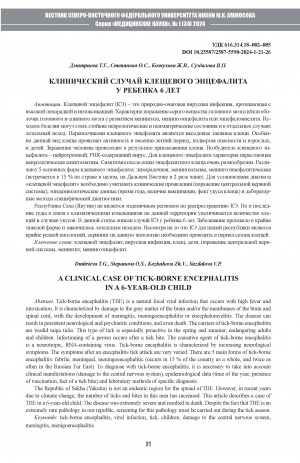Степанова Ольга Сергеевна
Место работы автора, адрес/электронная почта: ГБУ "Детская клиническая инфекционная больница" ; 677005, г. Якутск, ул. Курашова, 91/3 ; e-mail: stepanovaos80@mail.ru ; https://dikb.mzsakha.ru/
Документы 1 - 1 из 1
Авторы:
Количество страниц: 6 с.
Клещевой энцефалит (КЭ) - это природно-очаговая вирусная инфекция, протекающая с высокой лихорадкой и интоксикацией. Характерно поражение серого вещества головного мозга и/или оболочек головного и спинного мозга с развитием менингита, менингоэнцефалита или энцефаломиелита. Исходом болезни могут стать стойкие неврологические и психиатрические состояния и в отдельных случаях летальный исход. Переносчиками клещевого энцефалита являются иксодовые таежные клещи. Особенно данный вид клеща проявляет активность в весенне-летний период, подвергая опасности и взрослых, и детей. Заражение человека происходит в результате присасывания клеща. Возбудитель клещевого энцефалита - нейротропный, РНК-содержащий вирус. Для клещевого энцефалита характерна нарастающая неврологическая симптоматика. Симптомы после атаки энцефалитного клеща очень разнообразны. Различают 5 основных форм клещевого энцефалита: лихорадочная, менингеальная, менингоэнцефалитическая (встречается в 15 % по стране в целом, на Дальнем Востоке в 2 раза чаще). Для установления диагноза "клещевой энцефалит" необходимо учитывать клинические проявления (поражение центральной нервной системы), эпидемиологические данные (время года, наличие вакцинации, факт укуса клеща) и лабораторные методы специфической диагностики. Республика Саха (Якутия) не является эндемичным регионом по распространению КЭ. Но в последние годы в связи с климатическими изменениями на данной территории увеличивается количество клещей и случаев укусов. В данной статье описан случай КЭ у ребенка 6 лет. Заболевание протекало в крайне тяжелой форме и закончилось летальным исходом. Несмотря на то что КЭ для нашей республики является крайне редкой патологией, скрининг на данную патологию необходимо проводить в период сезона клещей.
Tick-borne encephalitis (TBE) is a natural focal viral infection that occurs with high fever and intoxication. It is characterized by damage to the gray matter of the brain and/or the membranes of the brain and spinal cord, with the development of meningitis, meningoencephalitis or encephalomyelitis. The disease can result in persistent neurological and psychiatric conditions, and even death. The carriers of tick-borne encephalitis are ixodid taiga ticks. This type of tick is especially proactive in the spring and summer, endangering adults and children. Infectioning of a person occurs after a tick bite. The causative agent of tick-borne encephalitis is a neurotropic, RNA-containing virus. Tick-borne encephalitis is characterized by increasing neurological symptoms. The symptoms after an encephalitis tick attack are very varied. There are 5 main forms of tick-borne encephalitis: febrile, meningeal, meningoencephalitic (occurs in 15 % of the country as a whole, and twice as often in the Russian Far East). To diagnose with tick-borne encephalitis, it is necessary to take into account clinical manifestations (damage to the central nervous system), epidemiological data (time of the year, presence of vaccination, fact of a tick bite) and laboratory methods of specific diagnosis. The Republic of Sakha (Yakutia) is not an endemic region for the spread of TBE. However, in recent years due to climate change, the number of ticks and bites in this area has increased. This article describes a case of TBE in a 6-year-old child. The disease was extremely severe and resulted in death. Despite the fact that TBE is an extremely rare pathology in our republic, screening for this pathology must be carried out during the tick season.
Tick-borne encephalitis (TBE) is a natural focal viral infection that occurs with high fever and intoxication. It is characterized by damage to the gray matter of the brain and/or the membranes of the brain and spinal cord, with the development of meningitis, meningoencephalitis or encephalomyelitis. The disease can result in persistent neurological and psychiatric conditions, and even death. The carriers of tick-borne encephalitis are ixodid taiga ticks. This type of tick is especially proactive in the spring and summer, endangering adults and children. Infectioning of a person occurs after a tick bite. The causative agent of tick-borne encephalitis is a neurotropic, RNA-containing virus. Tick-borne encephalitis is characterized by increasing neurological symptoms. The symptoms after an encephalitis tick attack are very varied. There are 5 main forms of tick-borne encephalitis: febrile, meningeal, meningoencephalitic (occurs in 15 % of the country as a whole, and twice as often in the Russian Far East). To diagnose with tick-borne encephalitis, it is necessary to take into account clinical manifestations (damage to the central nervous system), epidemiological data (time of the year, presence of vaccination, fact of a tick bite) and laboratory methods of specific diagnosis. The Republic of Sakha (Yakutia) is not an endemic region for the spread of TBE. However, in recent years due to climate change, the number of ticks and bites in this area has increased. This article describes a case of TBE in a 6-year-old child. The disease was extremely severe and resulted in death. Despite the fact that TBE is an extremely rare pathology in our republic, screening for this pathology must be carried out during the tick season.
Клинический случай клещевого энцефалита уребенка 6 лет / Дмитриева Т. Г., Степанова О. С., Кожухова Ж. В. [и др.] ; Северо-Восточный федеральный университет им. М.К. Аммосова, Медицинский институт, ГБУ "Детская клиническая инфекционная больница" // Вестник Северо-Восточного федерального университета им. М. К. Аммосова. Серия "Медицинские науки". - 2024. - N 1 (34). - C. 21-26. - DOI: 10.25587/2587-5590-2024-1-21-26
DOI: 10.25587/2587-5590-2024-1-21-26
